An Analytical Model for BDS B1 Spreading Code Self-Interference Evaluation Considering NH Code Effects
Abstract
:1. Introduction
2. Signal and Correlator Model
3. SSC and Equivalent White Noise Level
3.1. Data Bits Aligned
3.2. Data Bits Misaligned by an Integer Number of Code Chips
3.3. Data Bits Misaligned by a Fraction of a Code Chip
4. Proposed Model for BDS MEO/IGSO B1-I Self-Interference
5. Model Validation
5.1. Criterion
5.2. Test Setup
5.3. Results
6. Results
- (1)
- Within most of the simulation interval, the individual equivalent noise and aggregate noise is below −215 dBW/Hz, which is much lower than a typical receiver noise floor of about −201.5 dBW/Hz, and therefore would not cause much trouble for most applications. Here trouble means worsening of such receiver capabilities as acquisition sensitivity and tracking jitter.
- (2)
- During 200 and 240 s, the equivalent noise of PRN 8 and the aggregate noise reaches −200 dBW/Hz. For a typical value of receiver noise floor (−201.5 dBW/Hz), this noise floor will be transferred to −197.67 dBW/Hz. In this case, PRN 6’s effective carrier to noise density ratio (Cs/N0)eff is 3.83 dB lower than the original carrier to noise density ratio, should the self-interference caused by PRN 8 be absent. This could pose a serious problem to high-sensitivity processing during acquisition, tracking or navigation bit modulation. The potential hazard caused by this (C/N0)eff decrease could be best exemplified by Figure 13, which shows the code tracking standard deviation versus (Cs/N0)eff , using established analytical method by Zhang and Zhan [19]. The B1-I receiver used in Figure 13 is assumed to have a precorrelation bandwidth of 4 MHz, a sampling frequency of 16 MHz, and 2-bit quantization. The coherent integration interval is 20 ms and a Dot Product discriminator is used. When (C/N0)eff decreases from 19 to 15 dB-Hz, tracking standard deviation increases from 11.07 m to 22.72 m. In this regard, B1-I self-interference could pose a potential hazard on pseudorange measurement for high-sensitivity receivers. However, it must be underlined that for most receivers (from mass market to medium-grade receiver), a (C/N0)eff value under 20 dB-Hz, though may be possible, is an exceptional case. When (C/N0)eff decreases from 24 to 20 dB-Hz, tracking standard deviation increases from 5 m to 9 m, which does not impose significant impact on final positioning accuracy for most low- to medium-grade receivers.
- (3)
- Around 240 s for PRN 8 and around 1200 s for PRN 9, the self-interference effect on the desired signal PRN 6 reaches its maximal value for each undesired signal respectively. This corresponds to the time when these two PRN’s Doppler shift (modulo 1 kHz) are aligned (zero differential Doppler shift) with the desired signal, PRN 6. The same situation has also been found in GPS C/A-to-C/A self-interference [4].
7. Conclusions
Acknowledgments
Author Contributions
Conflicts of Interest
Appendix A. Autocorrelation Correlation Function Derivations
Appendix A.1. Undesired Signal ACF
Appendix A.2. Desired Signal ACF
Appendix B. Correlator Output Variance Derivations
Appendix B.1. Data Bits Aligned
Appendix B.2. Data Bits Misaligned by an Integer Number of Code Chips
Appendix C. Simulation Case For Section “Results”
| SatelliteNo. | Inclination (degrees) | Right Ascension of the Ascending Node (degrees) | Eccentricity | Argument of Perigee (degrees) | Mean Anomaly (degrees) | Mean Motion (revol. per day) |
|---|---|---|---|---|---|---|
| 36287 | 1.6224 | 10.9309 | 0.0003751 | 185.3235 | 28.1598 | 1.00265967 |
| 36590 | 1.5085 | 29.1093 | 0.0004961 | 300.4656 | 312.7627 | 1.00277041 |
| 36828 | 54.3192 | 201.2797 | 0.0039362 | 203.8556 | 127.6677 | 1.00249186 |
| 37210 | 0.9282 | 51.9435 | 0.0005461 | 156.2428 | 31.2782 | 1.00271739 |
| 37256 | 54.0451 | 320.3427 | 0.0030637 | 199.8493 | 312.3901 | 1.00256291 |
| 37384 | 56.8805 | 81.1849 | 0.0025638 | 195.5632 | 159.1983 | 1.00273265 |
| 37763 | 54.6352 | 203.5192 | 0.0035745 | 204.2305 | 243.6925 | 1.00288677 |
| 37948 | 54.1427 | 319.7862 | 0.0029394 | 199.0165 | 307.8874 | 1.00268580 |
| 38091 | 1.0914 | 26.4422 | 0.0000830 | 112.2111 | 164.4866 | 1.00268964 |
| 38250 | 55.7223 | 80.5201 | 0.0023395 | 212.3740 | 12.3101 | 1.86233381 |
| 38251 | 55.6585 | 80.0001 | 0.0025721 | 205.4810 | 17.6455 | 1.86234185 |
| 38774 | 54.7564 | 200.2406 | 0.0034012 | 171.3479 | 188.7571 | 1.86251530 |
| 38775 | 54.8606 | 199.7656 | 0.0019260 | 217.0437 | 222.9654 | 1.86233085 |
| 38953 | 0.1374 | 20.0179 | 0.0001222 | 337.9805 | 294.8131 | 1.00272848 |
References
- Morton, Y.; Miller, M.; Tsui, J.; Lin, D.; Zhou, Q. GPS Civil Signal Self-Interference Mitigation During Weak Signal Acquisition. IEEE Trans. Signal Process. 2007, 55, 5859–5863. [Google Scholar] [CrossRef]
- Gao, G.X.; Enge, P. How Many GNSS Satellites are Too Many? IEEE Trans. Aerosp. Electron. Syst. 2012, 48, 2865–2874. [Google Scholar]
- Cerruti, A.P.; Rushanan, J.J.; Winters, D.W. Modeling C/A on C/A interference. In Proceedings of the 2009 International Technical Meeting of The Institute of Navigation, Anaheim, CA, USA, 26–28 January 2009; pp. 142–156. [Google Scholar]
- Cerruti, A.P.; Betz, J.W.; Rushanan, J.J. Further investigations into C/A-to-C/A interference. In Proceedings of the 2014 International Technical Meeting of The Institute of Navigation, San Diego, CA, USA, 27–29 January 2014; pp. 349–361. [Google Scholar]
- Liu, L.; Zhan, X.; Liu, W.; Niu, M. Assessment of Radio Frequency Compatibility between Compass Phase II and Other GNSSs. J. Navig. 2011, 64, 55–72. [Google Scholar]
- Liu, W.; Du, G.; Zhan, X.; Zhai, C. Assessment of Radio Frequency Compatibility Relevant to the Galileo E1/E6 and Compass B1/B3 Bands. J. Navig. 2010, 63, 419–434. [Google Scholar] [CrossRef]
- Hegarty, C.; Tran, M.; Lee, Y. Simplified techniques for analyzing the effects of non-white interference on GPS receivers. In Proceedings of the 15th International Technical Meeting of the Satellite Division of The Institute of Navigation (ION GPS 2002), Portland, OR, USA, 24–27 September 2002; pp. 620–629. [Google Scholar]
- Dierendonck, A.J.V.; Hegarty, C. Methodologies for assessing intrasystem and intersystem interference to satellite navigation systems. In Proceedings of the 15th International Technical Meeting of the Satellite Division of the Institute of Navigation (ION GPS 2002), Portland, OR, USA, 24–27 September 2002; pp. 1241–1250. [Google Scholar]
- Hegarty, C.; Dierendonck, A.J.V. Recommendations on digital distortion requirements for the civil GPS signals. Proceeding of IEEE/ION-PLANS-2008: Position, Location and Navigation Symposium, Monterey, CA, USA, 6–8 May 2008; pp. 1090–1099. [Google Scholar]
- Shibata, T.; Maeda, H. Extended theory of spectral separation coefficient for GNSS signal interference. In Proceedings of the 2010 International Technical Meeting of the Institute of Navigation, San Diego, CA, USA, 25–27 January 2010; pp. 930–940. [Google Scholar]
- Dierendonck, A.J.V.; Erlandson, R.J.; Shallberg, K.; Ericson, S. The inadequacy of the spectral separation coefficient and aggregate gain factor for quantifying the effects of GPS C/A code self interference. Proceedings pf the 26th International Technical Meeting of the Satellite Division of the Institute of Navigation (ION GNSS+ 2013), Nashville, TN, USA, 16–20 September 2013; pp. 1435–1444. [Google Scholar]
- Hegarty, C. A simple model for C/A-code self-interference. In Proceedings of the 27th International Technical Meeting of The Satellite Division of the Institute of Navigation (ION GNSS+ 2014), Tampa, FL, USA, 8–12 September 2014; pp. 3484–3494. [Google Scholar]
- Golshan, R.; Fan, T.; Arrendondo, A.; Stansell, T. Implications of C/A-on-CA interference on carrier tracking loop performance. In Proceedings of the 27th International Technical Meeting of The Satellite Division of the Institute of Navigation (ION GNSS+ 2014), Tampa, FL, USA, 8–12 September 2014; pp. 3510–3525. [Google Scholar]
- Dierendonck, A.J.V.; Erlandson, R.; McGraw, G.; Coker, R. Determination of C/A code self-interference using cross-correlation simulations and receiver bench tests. In Proceedings of the 15th International Technical Meeting of the Satellite Division of The Institute of Navigation (ION GPS 2002), Portland, OR, USA, 24–27 September 2002; pp. 630–642. [Google Scholar]
- Bhuiyan, M.Z.H.; Söderholm, S.; Thombre, S.; Ruotsalainen, L.; Kuusniemi, H. Overcoming the Challenges of BeiDou Receiver Implementation. Sensors 2014, 14, 22082–22098. [Google Scholar] [CrossRef] [PubMed]
- Gardner, W.A. Introduction to Random Processes: With Applications to Signals and Systems, 2nd ed.; Mcgraw-Hill Inc.: New York, NY, USA, 1990. [Google Scholar]
- Betz, J.W.; Goldstein, D.B. Candidate designs for an additional civil signal in GPS spectral bands. In Proceedings of the 15th International Technical Meeting of the Satellite Division of The Institute of Navigation (ION GPS 2002), Portland, OR, USA, 24–27 September 2002; pp. 622–631. [Google Scholar]
- Betz, J.W.; Kolodziejski, K.R. Generalized theory of code tracking with an early-late discriminator part II: Noncoherent processing and numerical results. IEEE Trans. Aerosp. Electron. Syst. 2009, 45, 1557–1564. [Google Scholar] [CrossRef]
- Zhang, X.; Zhan, X.Q. Joint determination of precorrelation bandwidth, sampling frequency and quantization in wideband compass receivers. Navigation 2012, 59, 195–208. [Google Scholar] [CrossRef]
- Misra, P.; Enge, P. GPS Measurements and Error Sources. In Global Positioning System-Signals, Measurements, and Performance, 2nd ed.; Ganga-Jamuna Press: Lincoln, MA, USA, 2006. [Google Scholar]
- Hwa Create Co. HWA-RNSS-7400 Technical Specifications; Hwa Create Co., Ltd.: Beijing, China, 2015. [Google Scholar]
- Caspl Co. Multiconst Ellation Multifrequency Data Logging and Replay System (SAS6862A) Technical Specifications; CASPL Co., Ltd.: Shanghai, China, 2015. [Google Scholar]
- NORAD Two-Line Element Sets Current Data. North American Aerospace Defense Command. Available online: http://www.celestrak.com/NORAD/elements/ (accessed on 25 April 2015).
- Bhuiyan, M.Z.H.; Söderholm, S.; Kuusniemi, H.; Thombre, S.; Ruotsalainen, L. Utilization of a Novel Channel Quality Index for Improved Multi-GNSS Positioning in GNSS-denied Environments. In Proceedings of the 5th International Galileo Science Colloquium, Braunschweig, Germany, 27–29 October 2015. [Google Scholar]
- Muthuraman, K.; Borio, D. C/N0 estimation for modernized GNSS signals: Theoretical bounds and a novel iterative estimator. Navigation 2010, 57, 309–323. [Google Scholar] [CrossRef]
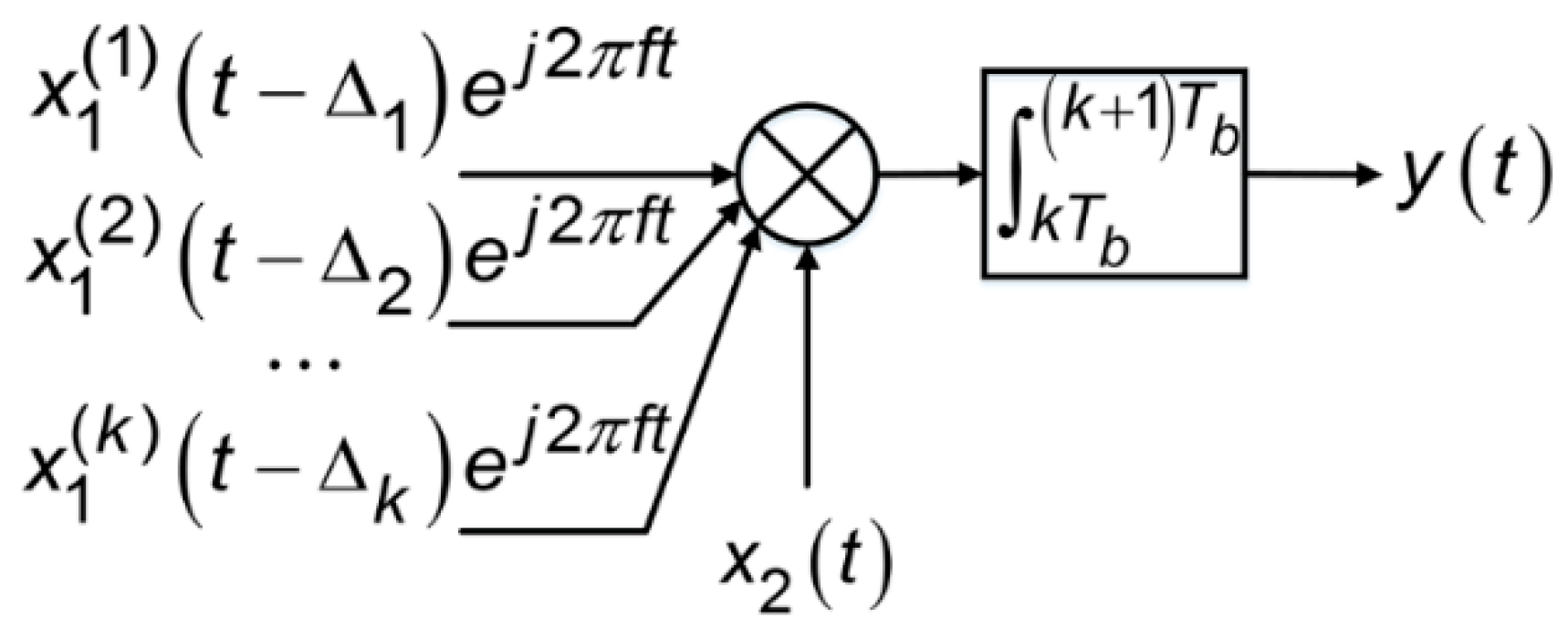
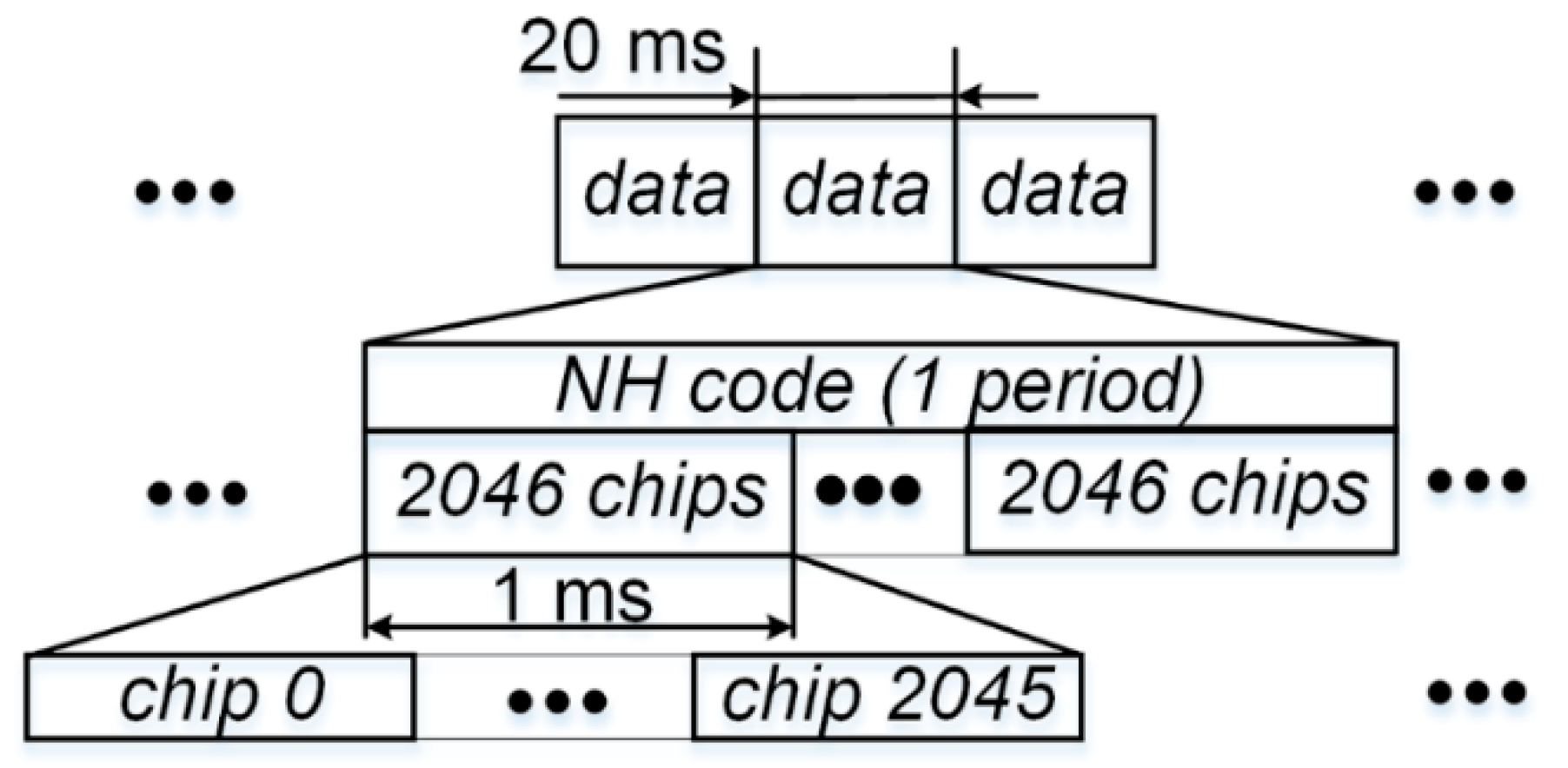

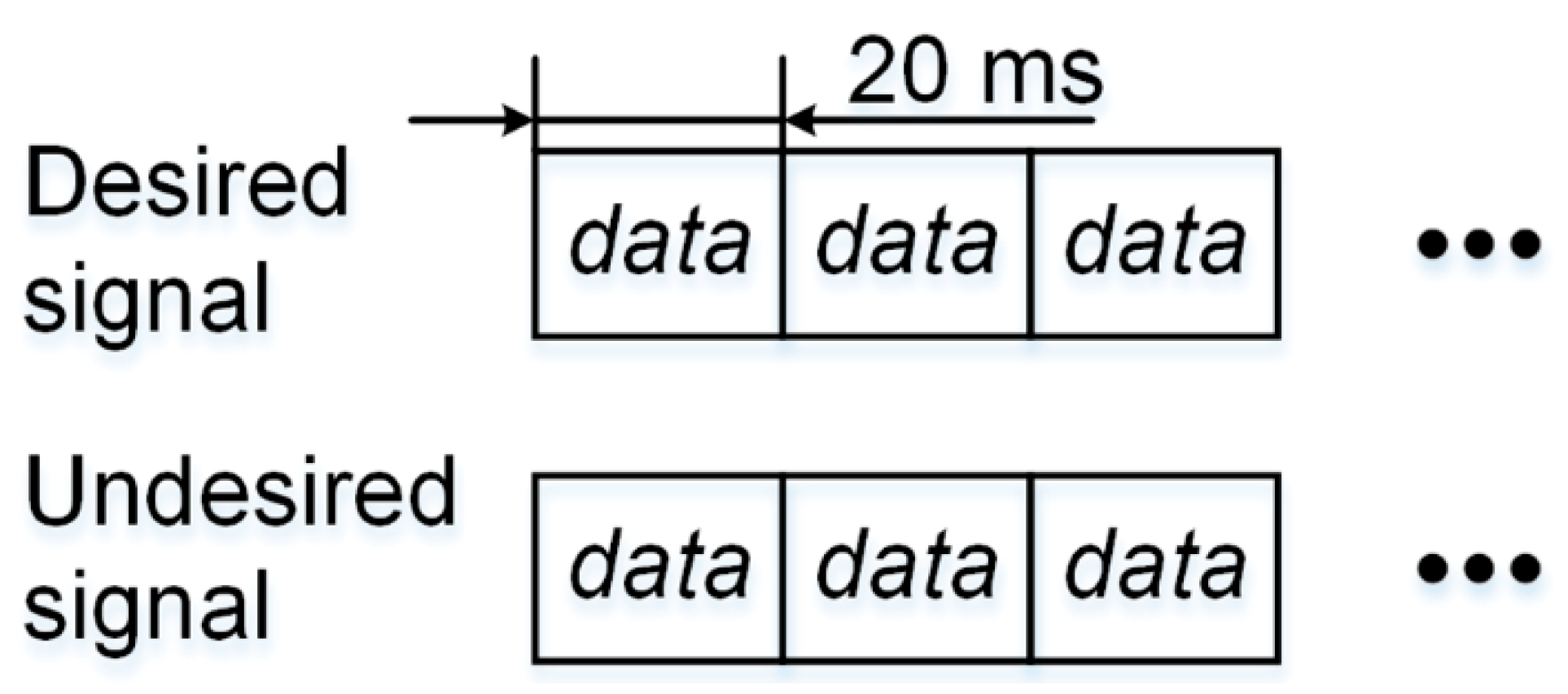
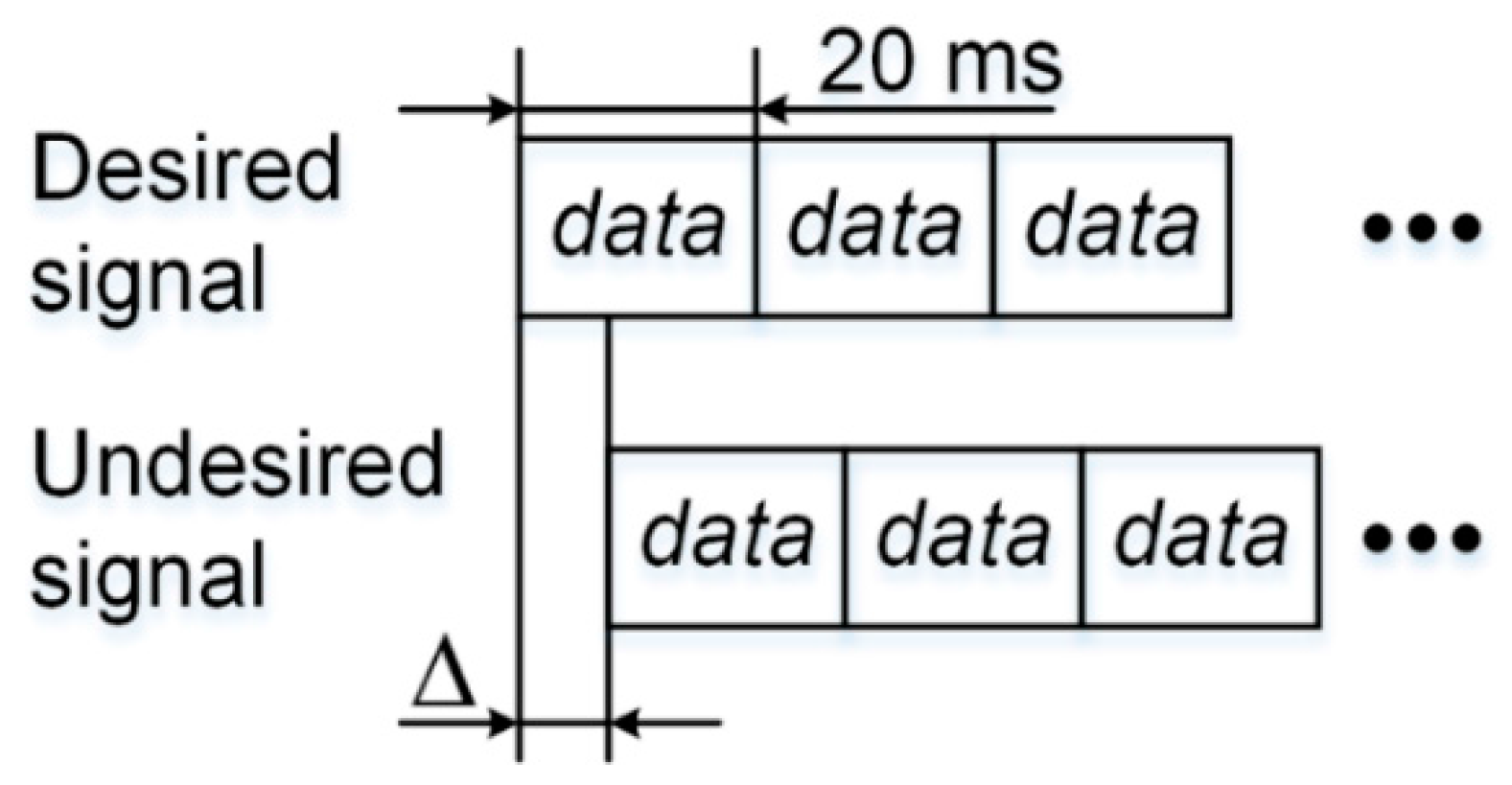
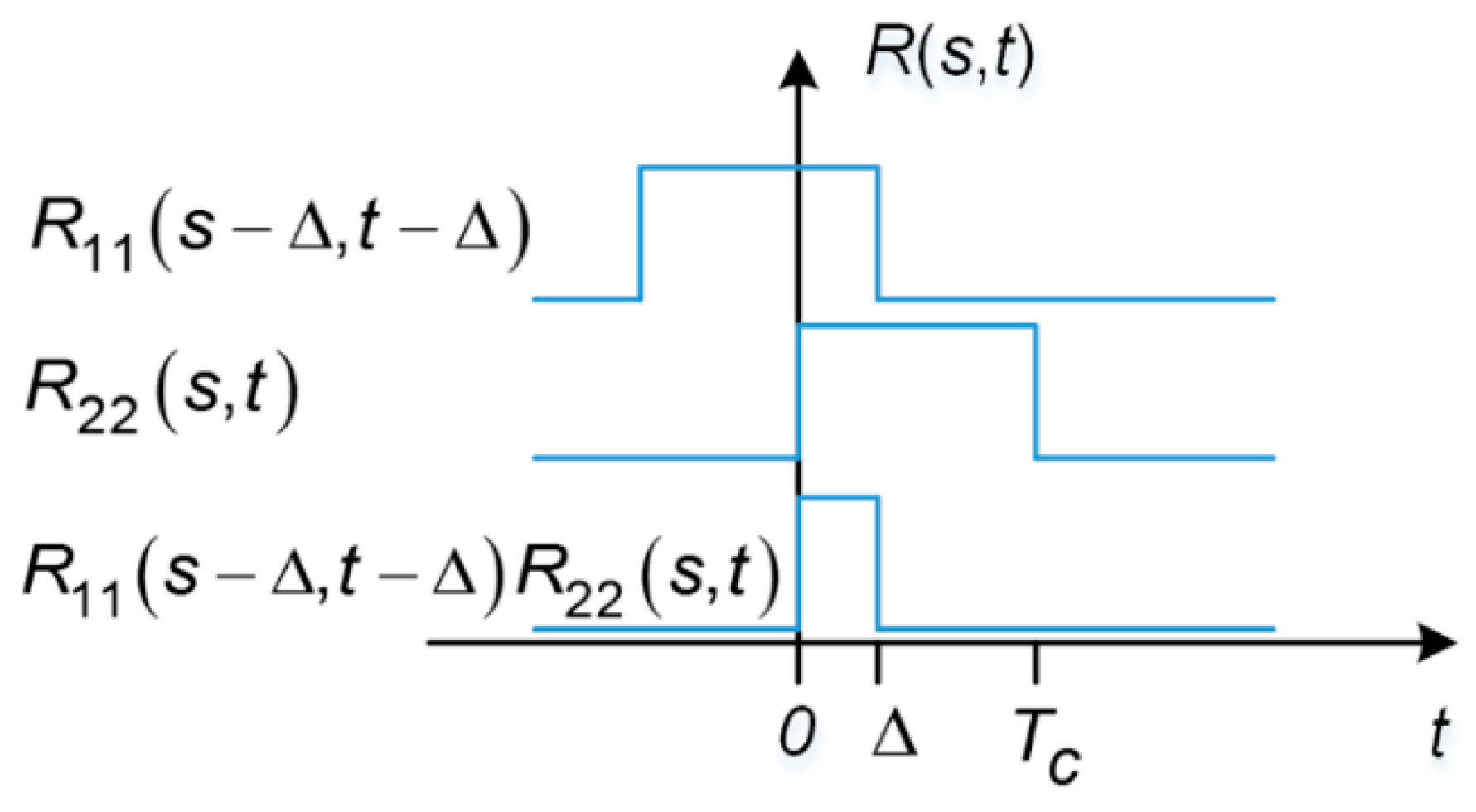
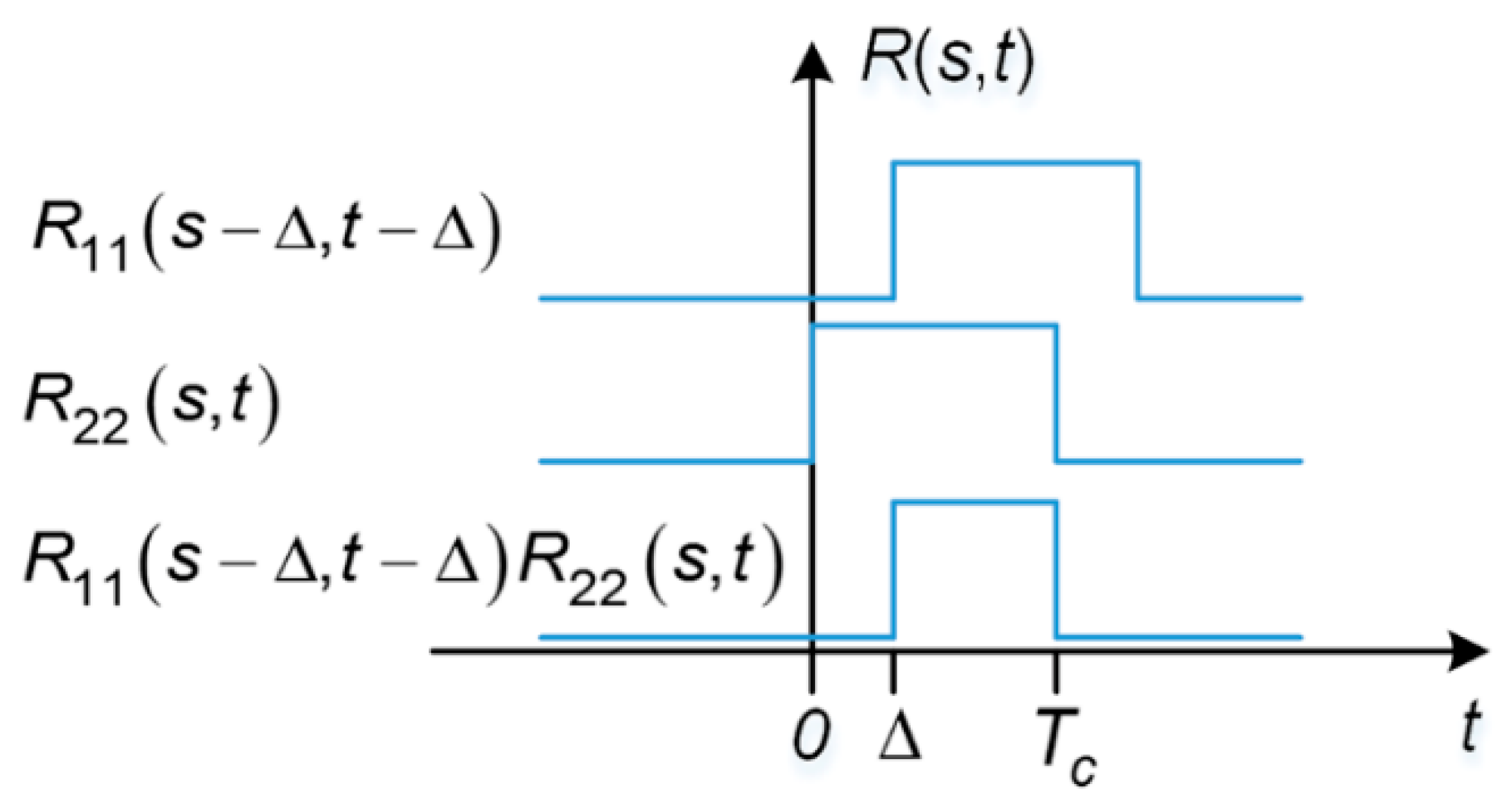

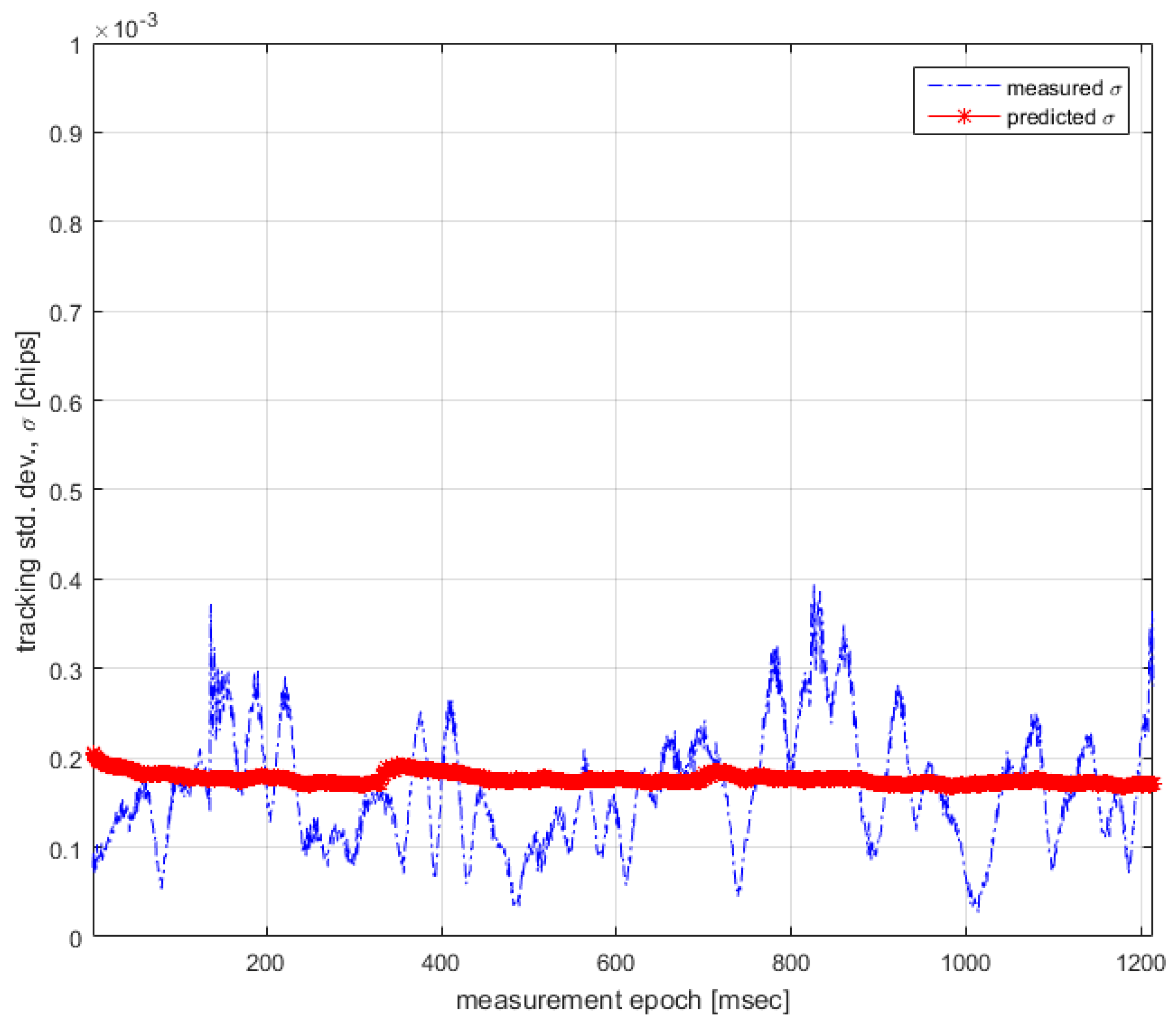
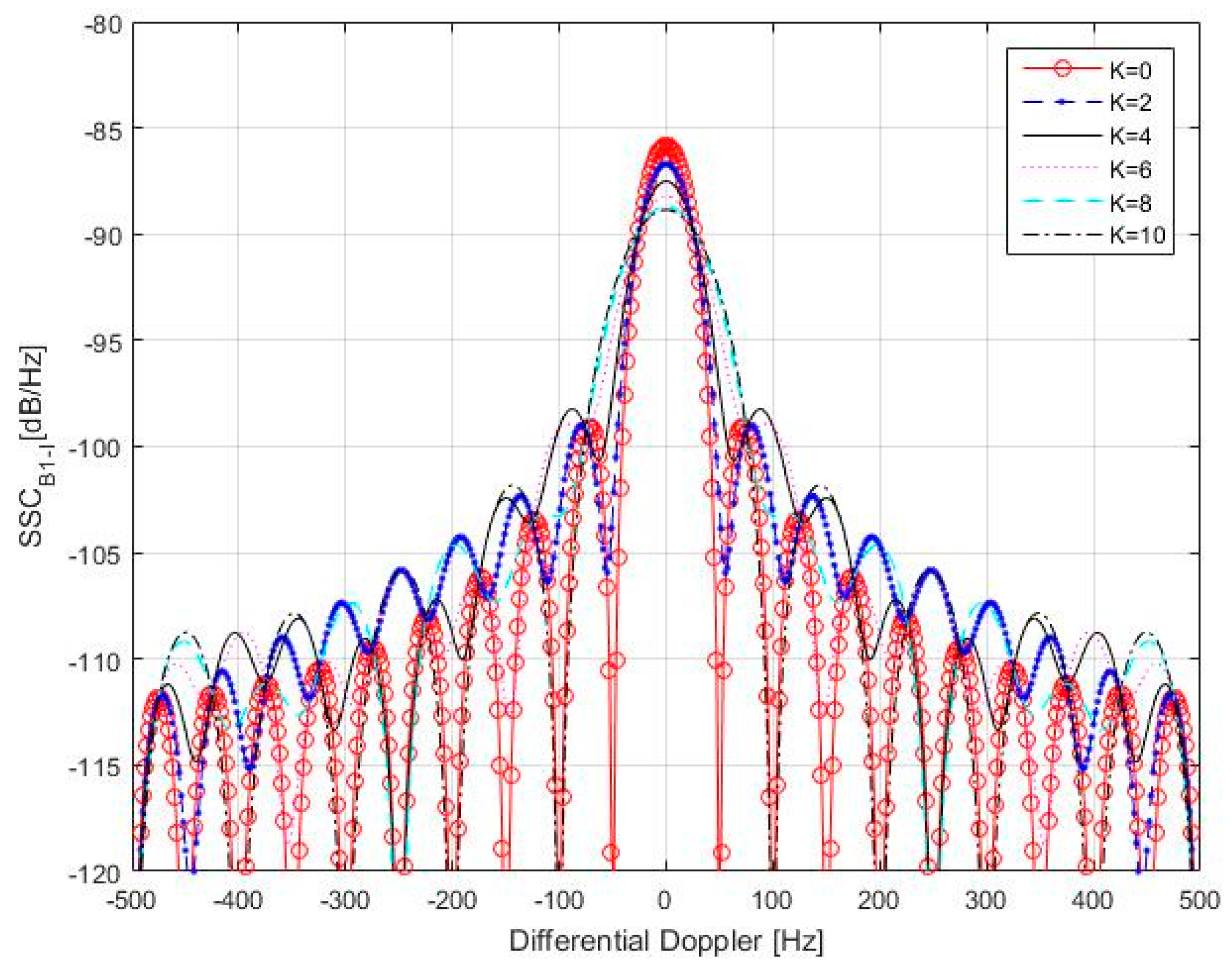
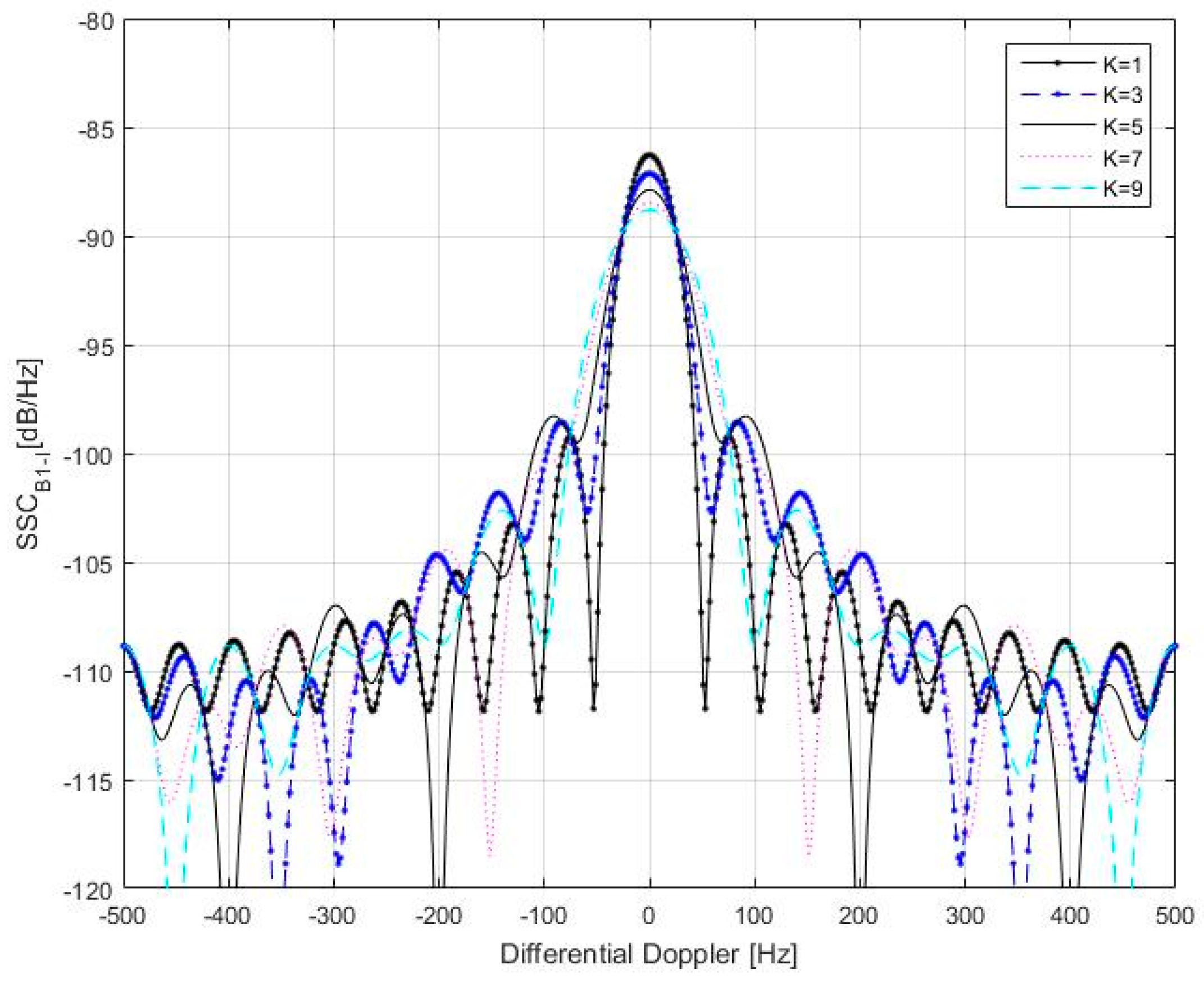
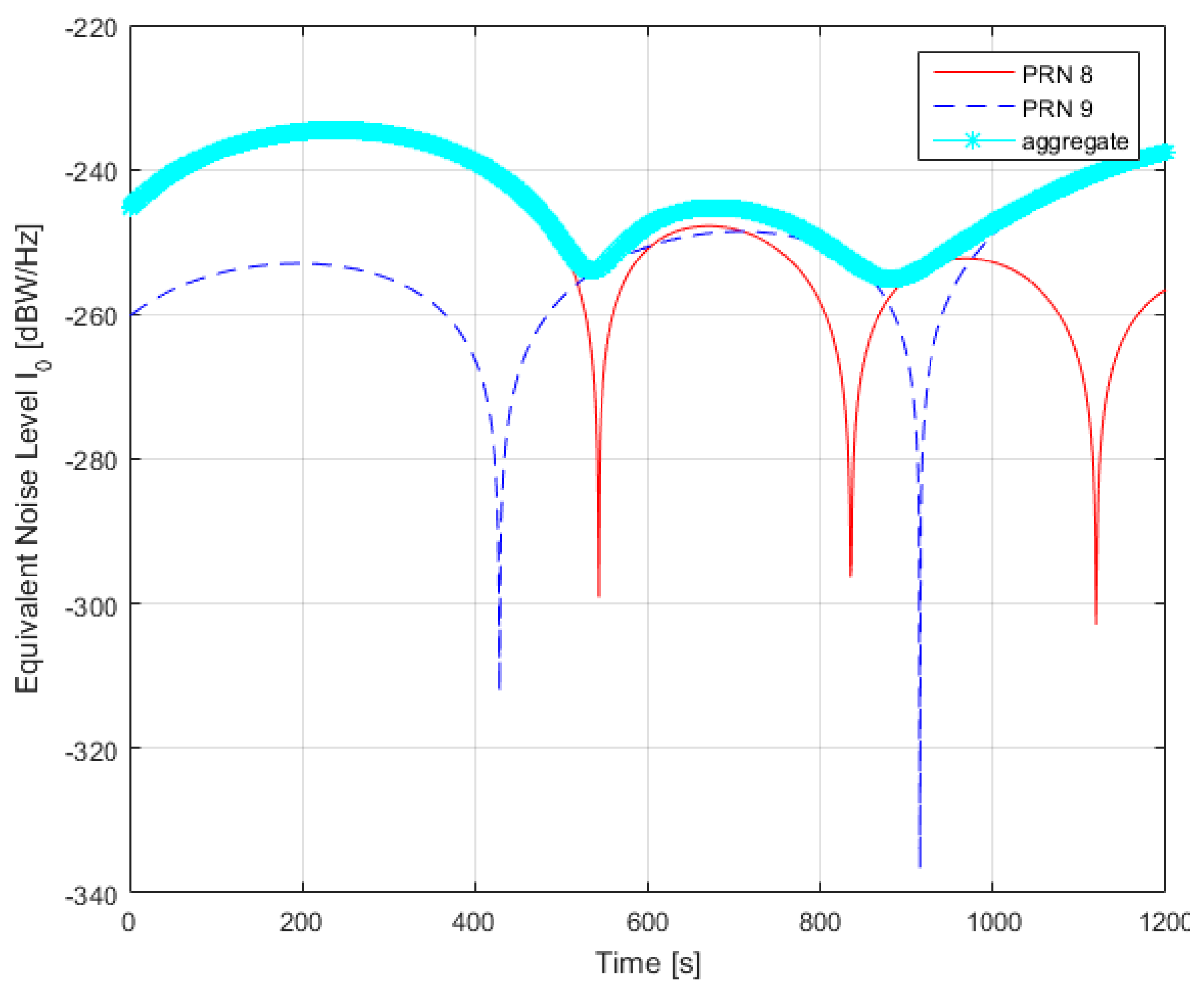
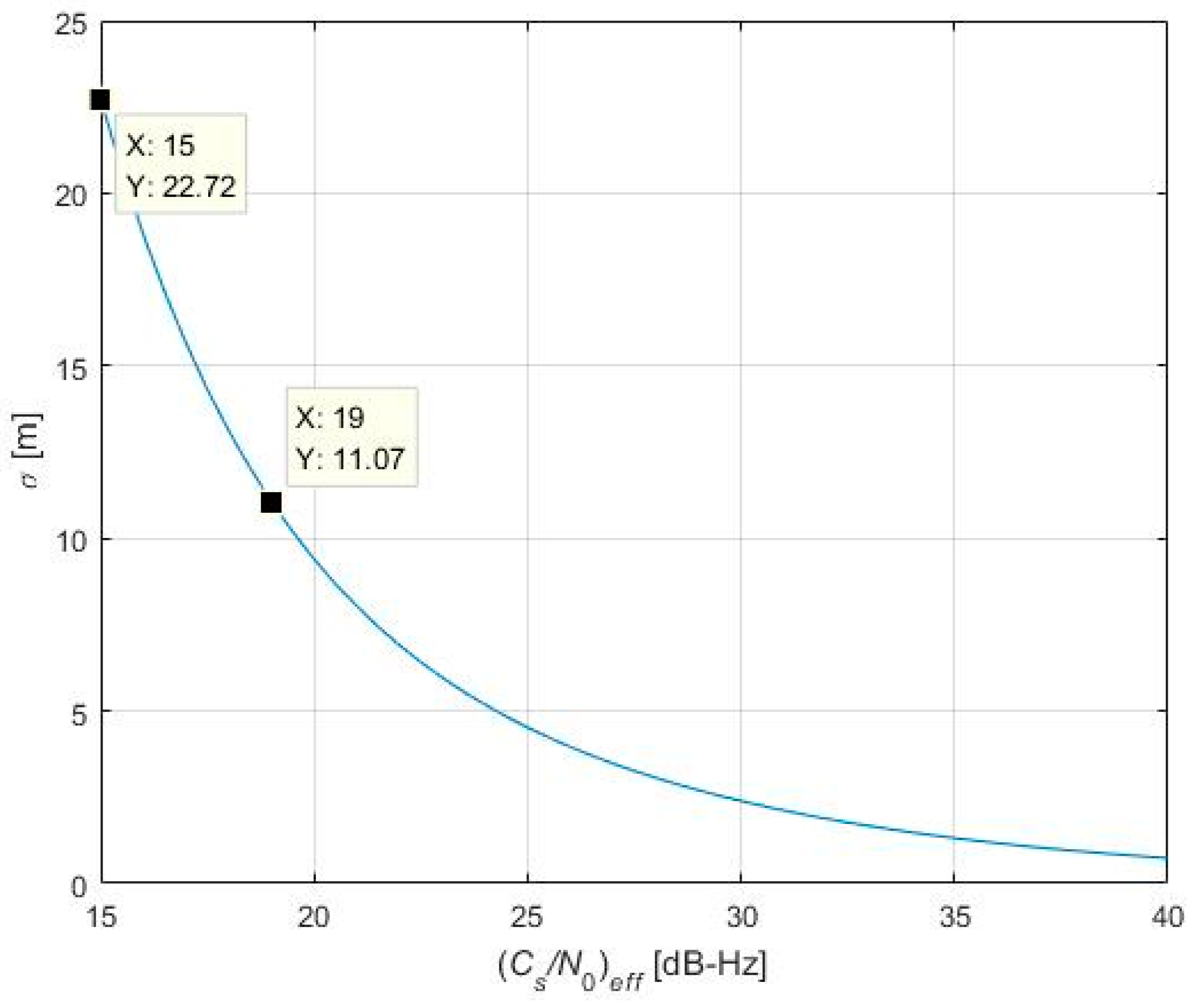
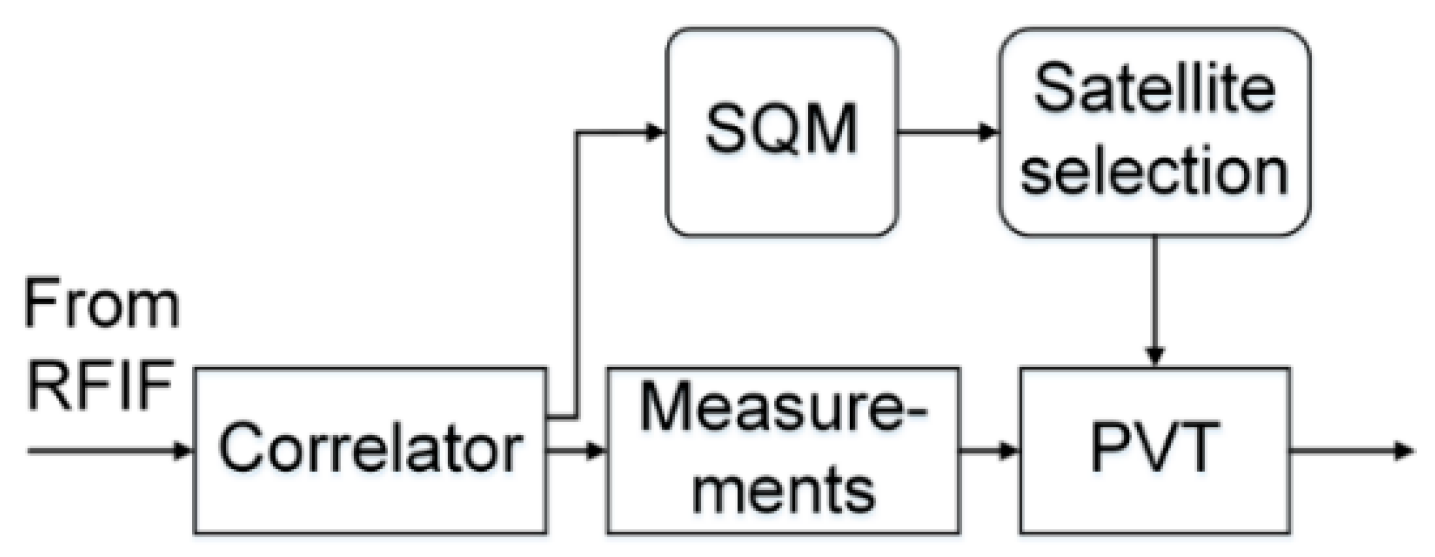
| PRN | Relative Received Power (dB) | True Range (m) | Doppler (Hz) | SSCB1-I (dB/Hz) | I0 (dBW/Hz) |
|---|---|---|---|---|---|
| 66 | 11.067 | 36,868,693 | −563.659 | - | - |
| 88 | 11.255 | 36,071,721 | −525.663 | −62.7 | −211.4 |
| 99 | 10.459 | 39,531,328 | 578.098 | −76.6 | −226.2 |
| Total | −211.3 | ||||
| 1: while GPS measurement do |
| 2: Use true range r to obtain transit time t by t = r/c, |
| where c is the speed of light in vacuum. |
| 3: Use relative received power p_rel to obtain actual |
| received power p by p = p_rel + p_ref, where |
| p_ref is the reference power set in the software simulator. |
| 4: Obtain differential Doppler f by differencing the first satellite with the rest. |
| 5: Obtain differential transit time ∆ by differencing the first satellite with the rest. |
| 6: Obtain the number of 1ms in ∆, K by K = floor (absolute value of ∆ × 103). |
| 7: Obtain the number of code chips in ∆, C by C = round( (∆ − K) × chip_rate × 10−3). |
| 8: if C is equal to code period (2046) then |
| 9: reset C. |
| 10: increment K. |
| 11: end if |
| 12: Use Equations (20) and (23) to obtain SSCB1-I. |
| 13: I0 = p + SSCB1-I. |
| 14: end while |
| Sections | Parameters | Values |
|---|---|---|
| Satellite Transmitter (TX) | TX bandwidth BT | 30.69 MHz |
| Target signal | BDS B1 | |
| Atmospheric Effects, multipath & RF interference | none | Not Applicable |
| RFFE | Pre-correlation Bandwidth Br | 4 MHz |
| Sampling frequency fs | 62 Msps | |
| Number of quantization levels NQ | 4 | |
| Noise floor | −203.5 dBW/Hz | |
| Power level at antenna | −160 dBW | |
| Software Receiver | DLL one-sided noise bandwidth BL | 1 Hz |
| Coherent Integration Time (CIT) CT | 20 ms | |
| Non-coherent Integration Time (NIT) NT | 1 | |
| Discriminator type | Dot product | |
| Early-late spacing ∆ | 0.5 chips |
© 2017 by the authors. Licensee MDPI, Basel, Switzerland. This article is an open access article distributed under the terms and conditions of the Creative Commons Attribution (CC BY) license (http://creativecommons.org/licenses/by/4.0/).
Share and Cite
Zhang, X.; Zhan, X.; Feng, S.; Ochieng, W. An Analytical Model for BDS B1 Spreading Code Self-Interference Evaluation Considering NH Code Effects. Sensors 2017, 17, 663. https://doi.org/10.3390/s17040663
Zhang X, Zhan X, Feng S, Ochieng W. An Analytical Model for BDS B1 Spreading Code Self-Interference Evaluation Considering NH Code Effects. Sensors. 2017; 17(4):663. https://doi.org/10.3390/s17040663
Chicago/Turabian StyleZhang, Xin, Xingqun Zhan, Shaojun Feng, and Washington Ochieng. 2017. "An Analytical Model for BDS B1 Spreading Code Self-Interference Evaluation Considering NH Code Effects" Sensors 17, no. 4: 663. https://doi.org/10.3390/s17040663





